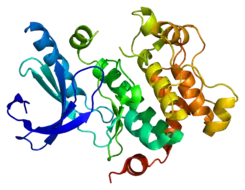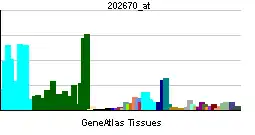MAP2K1
La MAP quinasa quinasa específica dual 1 (MAP2K1) es una enzima codificada en humanos por el gen MAP2K1.[1][2]
| MAP quinasa quinasa específica dual 1 | ||||
|---|---|---|---|---|
 Estructura tridimensional de la proteína MAP2K1. | ||||
| Estructuras disponibles | ||||
| PDB |
Lista de códigos PDB
| |||
| Identificadores | ||||
| Símbolos | MAP2K1 (HGNC: 6840) ; MAPKK1; MEK1; MKK1; PRKMK1 | |||
| Identificadores externos |
Bases de datos de enzimas
| |||
| Número EC | 2.7.12.2 | |||
| Locus | Cr. 15 q22.31 | |||
| Patrón de expresión de ARNm | ||||
 | ||||
| Más información | ||||
| Ortólogos | ||||
| Especies |
| |||
| Entrez |
| |||
| Ensembl |
| |||
| UniProt |
| |||
| RefSeq (ARNm) |
| |||
| RefSeq (proteína) NCBI |
| |||
| Ubicación (UCSC) |
| |||
| PubMed (Búsqueda) |
| |||
Esta quinasa pertenece a la familia de las proteínas quinasas específicas duales, que actúan como MAP quinasa quinasas. Las MAP quinasas, también conocidas como quinasas reguladas por señales extracelulares (ERKs), actúan como punto de integración de multitud de señales bioquímicas. MAP2K1 estimula actividad enzimática de las MAP quinasas por una amplia variedad de señales intra- y extracelulares. Como componente esencial de la ruta de transducción de señales mediada por p38, esta quinasa se encuentra implicada en multitud de procesos celulares como la proliferación celular, la diferenciación celular, la regulación de la transcripción y el desarrollo.[3]
Interacciones
La proteína MAP2K1 ha demostrado ser capaz de interaccionar con:
Referencias
- Rampoldi L, Zimbello R, Bortoluzzi S, Tiso N, Valle G, Lanfranchi G, Danieli GA (Mar de 1998). «Chromosomal localization of four MAPK signaling cascade genes: MEK1, MEK3, MEK4 and MEKK5». Cytogenet Cell Genet 78 (3-4): 301-3. PMID 9465908.
- Zheng CF, Guan KL (Jun de 1993). «Cloning and characterization of two distinct human extracellular signal-regulated kinase activator kinases, MEK1 and MEK2». J Biol Chem 268 (15): 11435-9. PMID 8388392.
- «Entrez Gene: MAP2K1 mitogen-activated protein kinase kinase 1».
- Yeung, K; Janosch P, McFerran B, Rose D W, Mischak H, Sedivy J M, Kolch W (mayo de 2000.). «Mechanism of suppression of the Raf/MEK/extracellular signal-regulated kinase pathway by the raf kinase inhibitor protein». Mol. Cell. Biol. (UNITED STATES) 20 (9): 3079-85. PMID 10757792. doi:10.1128/MCB.20.9.3079-3085.2000.
- Wunderlich, W; Fialka I, Teis D, Alpi A, Pfeifer A, Parton R G, Lottspeich F, Huber L A (Feb. de 2001). «A novel 14-kilodalton protein interacts with the mitogen-activated protein kinase scaffold mp1 on a late endosomal/lysosomal compartment». J. Cell Biol. (United States) 152 (4): 765-76. PMID 11266467. doi:10.1083/jcb.152.4.765.
- Schaeffer, H J; Catling A D, Eblen S T, Collier L S, Krauss A, Weber M J (Sep. de 1998). «MP1: a MEK binding partner that enhances enzymatic activation of the MAP kinase cascade». Science (UNITED STATES) 281 (5383): 1668-71. PMID 9767029. doi:10.1126/science.281.5383.1668.
- Nantel, A; Mohammad-Ali K, Sherk J, Posner B I, Thomas D Y (Apr. de 1998). «Interaction of the Grb10 adapter protein with the Raf1 and MEK1 kinases». J. Biol. Chem. (UNITED STATES) 273 (17): 10475-84. PMID 9553107. doi:10.1074/jbc.273.17.10475.
- Marti, A; Luo Z, Cunningham C, Ohta Y, Hartwig J, Stossel T P, Kyriakis J M, Avruch J (Jan. de 1997). «Actin-binding protein-280 binds the stress-activated protein kinase (SAPK) activator SEK-1 and is required for tumor necrosis factor-alpha activation of SAPK in melanoma cells». J. Biol. Chem. (UNITED STATES) 272 (5): 2620-8. PMID 9006895. doi:10.1074/jbc.272.5.2620.
- Butch, E R; Guan K L (Feb. de 1996). «Characterization of ERK1 activation site mutants and the effect on recognition by MEK1 and MEK2». J. Biol. Chem. (UNITED STATES) 271 (8): 4230-5. PMID 8626767. doi:10.1074/jbc.271.8.4230.
- Yung, Y; Yao Z; Hanoch T; Seger R (mayo de 2000.). «ERK1b, a 46-kDa ERK isoform that is differentially regulated by MEK». J. Biol. Chem. (UNITED STATES) 275 (21): 15799-808. PMID 10748187. doi:10.1074/jbc.M910060199.
- Zheng, C F; Guan K L (Nov. de 1993). «Properties of MEKs, the kinases that phosphorylate and activate the extracellular signal-regulated kinases». J. Biol. Chem. (UNITED STATES) 268 (32): 23933-9. PMID 8226933.
- Kuboki, Y; Ito M, Takamatsu N, Yamamoto K I, Shiba T, Yoshioka K (Dec. de 2000). «A scaffold protein in the c-Jun NH2-terminal kinase signaling pathways suppresses the extracellular signal-regulated kinase signaling pathways». J. Biol. Chem. (UNITED STATES) 275 (51): 39815-8. PMID 11044439. doi:10.1074/jbc.C000403200.
- Ito, M; Yoshioka K, Akechi M, Yamashita S, Takamatsu N, Sugiyama K, Hibi M, Nakabeppu Y, Shiba T, Yamamoto K I (Nov. de 1999). «JSAP1, a novel jun N-terminal protein kinase (JNK)-binding protein that functions as a Scaffold factor in the JNK signaling pathway». Mol. Cell. Biol. (UNITED STATES) 19 (11): 7539-48. PMID 10523642.
- Sanz-Moreno, Victoria; Casar Berta, Crespo Piero (mayo de 2003.). «p38alpha isoform Mxi2 binds to extracellular signal-regulated kinase 1 and 2 mitogen-activated protein kinase and regulates its nuclear activity by sustaining its phosphorylation levels». Mol. Cell. Biol. (United States) 23 (9): 3079-90. PMID 12697810. doi:10.1128/MCB.23.9.3079-3090.2003.
- Robinson, Fred L; Whitehurst Angelique W, Raman Malavika, Cobb Melanie H (Apr. de 2002). «Identification of novel point mutations in ERK2 that selectively disrupt binding to MEK1». J. Biol. Chem. (United States) 277 (17): 14844-52. PMID 11823456. doi:10.1074/jbc.M107776200.
- Xu Be; Stippec S, Robinson F L, Cobb M H (Jul. de 2001). «Hydrophobic as well as charged residues in both MEK1 and ERK2 are important for their proper docking». J. Biol. Chem. (United States) 276 (28): 26509-15. PMID 11352917. doi:10.1074/jbc.M102769200.
- Chen, Z; Cobb M H (mayo de 2001.). «Regulation of stress-responsive mitogen-activated protein (MAP) kinase pathways by TAO2». J. Biol. Chem. (United States) 276 (19): 16070-5. PMID 11279118. doi:10.1074/jbc.M100681200.
- Karandikar, M; Xu S, Cobb M H (Dec. de 2000). «MEKK1 binds raf-1 and the ERK2 cascade components». J. Biol. Chem. (UNITED STATES) 275 (51): 40120-7. PMID 10969079. doi:10.1074/jbc.M005926200.